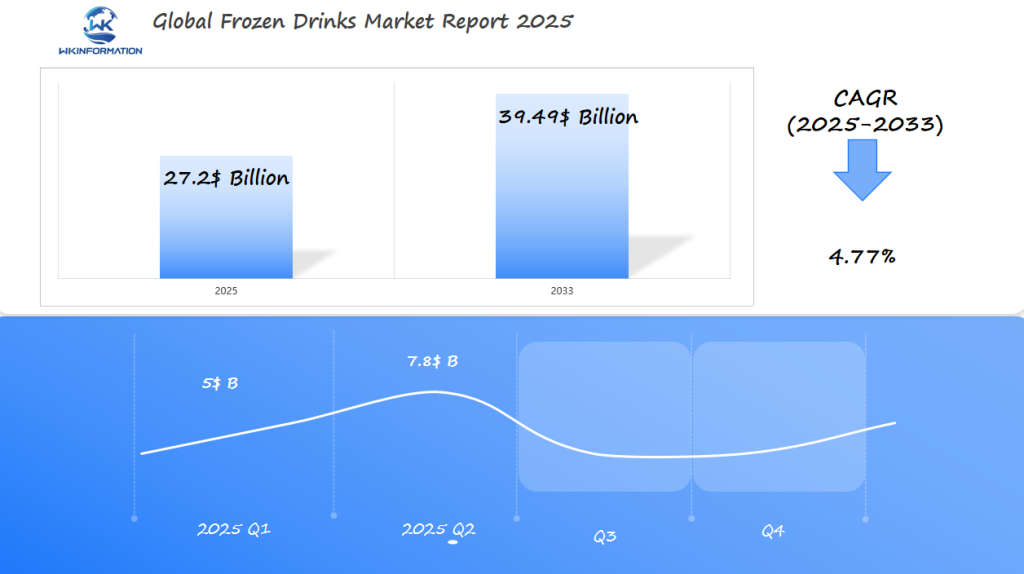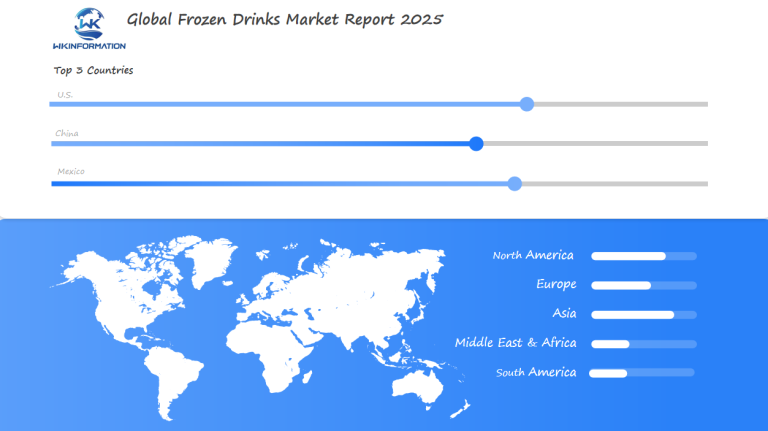Frozen Drinks Market Set to Skyrocket to $27.2 Billion Globally by 2025: Momentum Grows in the U.S., China, and Mexico
Explore comprehensive insights into the global Frozen Drinks Market, including upstream and downstream analysis, supply chain dynamics, and the latest trends shaping the industry. Understand emerging consumer preferences, key challenges, geopolitical impacts, and regional market shifts in the U.S., China, and Mexico. Discover product innovations, application-specific growth areas, and future market trajectories driven by health-conscious trends and evolving demand. Stay informed about regulatory challenges, trade dynamics, and opportunities for brands to expand and innovate in this competitive market.
- Last Updated:
Frozen Drinks Market Q1 and Q2 2025 Performance Insights
The Frozen Drinks market is forecast to reach $27.2 billion by the end of 2025, with a projected CAGR of 4.77% over the forecast period. Estimated revenue stands at around $5 billion in Q1, escalating to $7.8 billion in Q2. Q2 gains are particularly strong, driven by the seasonal spike in frozen beverage consumption during warmer months and aggressive summer promotional campaigns by global foodservice chains.
In the United States, the frozen drink sector thrives on innovation, including the introduction of healthier and functional frozen beverages. China is experiencing rapid growth in frozen tea and fruit-based slushies, supported by younger demographics and the booming quick-service restaurant sector. Mexico maintains a steady base of demand through traditional frozen drinks like “aguas frescas” and the expansion of urban food and beverage outlets offering westernized frozen products.

Key Takeaways
- The global market is projected to reach $27.2 billion by 2025.
- Increasing demand for refreshing beverages drives market growth.
- The rise of on-the-go culture contributes to the expansion.
- Changing consumer preferences fuel the growth of frozen beverages.
- The U.S. market is experiencing significant momentum.
Comprehensive Upstream and Downstream Analysis in the Frozen Drinks Market
A detailed analysis of the Frozen Drinks Market reveals the complex workings of its supply chain, from sourcing raw materials to distribution. The supply chain is a crucial part of the industry, affecting the overall efficiency and profitability of businesses.
The supply chain of the Frozen Drinks Market includes various players such as:
- Raw material suppliers
- Manufacturers
- Distributors
- Retailers
It is important to understand how this supply chain operates in order to pinpoint potential obstacles and areas that can be improved.
Understanding the Supply Chain Dynamics
The supply chain dynamics in the Frozen Drinks Market are complex, involving various stages from production to delivery.
Upstream Segment
The upstream segment focuses on raw material sourcing, including ingredients such as fruits, flavorings, and preservatives. The quality and availability of these raw materials significantly impact the final product’s quality and production costs.
Downstream Segment
The downstream segment encompasses manufacturing, packaging, and distribution. Manufacturers must adhere to stringent quality control measures to ensure the products meet consumer expectations. Effective distribution strategies are also crucial to maintain product freshness and availability across different regions.
Industry Analysis
Industry analysis reveals that advancements in technology and logistics have improved supply chain efficiency in the Frozen Drinks Market. For instance, the adoption of cold chain logistics has enabled the transportation of frozen products over long distances without compromising their quality.
Market Trends
Moreover, market trends indicate a growing demand for sustainable and eco-friendly packaging solutions. Companies are responding by adopting environmentally friendly packaging materials and practices, which not only reduce their environmental footprint but also appeal to environmentally conscious consumers.
Key Stages of Supply Chain in Frozen Drinks Market
- Raw material sourcing and procurement
- Manufacturing and quality control
- Packaging and branding
- Distribution and logistics
- Retail and consumer engagement
By understanding the supply chain dynamics and staying abreast of market trends, stakeholders in the Frozen Drinks Market can make informed decisions to optimize their operations and improve their competitiveness.
Latest Trends Powering the Global Frozen Drinks Market
The global frozen drinks market is experiencing significant growth, driven by changing consumer preferences. As consumers become more health-conscious and demanding in terms of taste and convenience, the market is responding with innovative products and flavors.
Emerging Trends and Consumer Preferences
The demand for low-calorie and natural ingredients is on the rise, influencing manufacturers to reformulate their products. Healthier options are becoming increasingly popular, with consumers seeking out frozen drinks that are not only tasty but also nutritious.
Premiumization is another trend observed in the market, where consumers are willing to pay more for high-quality products that offer unique experiences. This includes premium ingredients, unique flavors, and sustainable packaging.
The impact of health and wellness on frozen drinks is significant. Consumers are increasingly looking for products that align with their health goals. This has led to a rise in demand for:
- Low-calorie and sugar-free frozen drinks
- Products made with natural ingredients and fewer artificial additives
- Frozen drinks fortified with vitamins, minerals, and other nutrients
Brands that innovate and cater to these demands are likely to capture a significant share of the growing market. By focusing on health and wellness, companies can not only drive sales but also contribute to the well-being of their consumers.
Key Restrictions Holding Back the Frozen Drinks Market Growth
The Frozen Drinks Market is expected to grow, but there are several key factors preventing it from doing so. It’s important for stakeholders to understand these challenges in order to navigate the market effectively.
Challenges Facing the Frozen Drinks Industry
The Frozen Drinks industry faces a multitude of challenges that impact its growth and profitability.
Regulatory Issues
Compliance with food safety and environmental regulations is a significant concern for manufacturers. This includes adhering to food safety standards such as maintaining proper storage temperatures and handling practices to prevent contamination.
Supply Chain Disruptions
Issues like raw material shortages, transportation delays, and logistics problems pose another significant challenge. These disruptions can directly affect the availability and cost of frozen drinks.
Consumer Concerns
There is a growing demand for healthier and more sustainable products, which manufacturers must address to remain competitive. Consumer concerns about health and environmental impact are also influencing the market.
| Challenge | Description | Impact |
| Regulatory Issues | Compliance with food safety and environmental regulations | Increased operational costs |
| Supply Chain Disruptions | Raw material shortages, transportation delays | Reduced product availability, increased costs |
| Consumer Concerns | Demand for healthier and more sustainable products | Need for product reformulation and sustainable practices |

Geopolitical Impacts on the Frozen Drinks Supply Chain
Geopolitical tensions and trade policies play a crucial role in shaping the frozen drinks supply chain. The complex nature of global trade significantly affects the availability and pricing of frozen drinks, which in turn impacts the overall growth and competitiveness of the market.
The frozen drinks market is highly vulnerable to shifts in global trade policies, such as tariffs and trade agreements. For example, when tariffs are imposed on imported goods, it can lead to higher costs for both raw materials and finished products. This increase in expenses has the potential to disrupt supply chains and create instability in the market.
Global Trade Dynamics and Market Implications
The global trade landscape is complex, with various factors influencing the frozen drinks supply chain. Tariffs, quotas, and trade agreements are some of the key elements that can impact the market. For example, trade tensions between major economies can lead to increased costs for manufacturers and suppliers, which may be passed on to consumers.
The implications of these geopolitical factors on the frozen drinks market are multifaceted. They can lead to supply chain disruptions, increased costs, and changes in consumer behavior. Understanding these dynamics is crucial for stakeholders to navigate the market effectively.
| Geopolitical Factor | Impact on Supply Chain | Market Implication |
| Tariffs on Imports | Increased cost of raw materials and finished goods | Higher prices for consumers, potential decrease in demand |
| Trade Agreements | Reduced tariffs, increased trade volumes | Increased market competitiveness, potential for growth |
| Geopolitical Tensions | Supply chain disruptions, increased uncertainty | Market volatility, potential for shortages |
The geopolitical impacts on the frozen drinks supply chain are significant, with global trade dynamics playing a crucial role in shaping the market. Understanding these factors is essential for stakeholders to make informed decisions and navigate the complexities of the global frozen drinks market.
Type-Specific Analysis and Innovation Trends in the Frozen Drinks Market
Type-specific analysis reveals a dynamic landscape in the frozen drinks market, with emerging trends and innovations. The market is segmented into various categories, including frozen juices, frozen coffee, and frozen tea, each with its unique growth drivers and consumer preferences.
Product Innovations and Emerging Categories
The frozen juices category is witnessing significant innovation, with brands introducing new flavors and blends that cater to the growing demand for healthy and natural beverages. Functional frozen juices with added benefits like immunity boosters or digestive health are gaining traction.
Frozen coffee is another category experiencing rapid growth, driven by the increasing popularity of coffee culture and the convenience offered by frozen coffee products. Cold brew and nitro cold brew frozen coffee products are emerging as consumer favorites.
The frozen tea category is also evolving, with innovations in flavors and formats. Ready-to-drink frozen tea products are becoming increasingly popular, offering consumers a refreshing and convenient beverage option.
| Category | Innovation Trends | Consumer Preferences |
| Frozen Juices | New flavors, functional benefits | Healthy, natural ingredients |
| Frozen Coffee | Cold brew, nitro cold brew | Convenience, coffee culture |
| Frozen Tea | Ready-to-drink, flavor innovations | Refreshing, convenient |
These type-specific innovations and emerging categories are driving growth in the frozen drinks market, offering brands opportunities to differentiate themselves and cater to evolving consumer preferences.
Application-Specific Growth Areas in the Frozen Drinks Industry
The frozen drinks market is growing, and with that growth comes new opportunities in different areas. The industry is seeing a notable change in specific areas where growth is happening, influenced by evolving consumer tastes and improvements in how products are distributed.
Expanding Applications and Emerging Opportunities
The frozen drinks industry is experiencing growth across multiple application areas, including the foodservice sector, retail, and online channels. In the foodservice sector, frozen drinks are becoming increasingly popular in restaurants, cafes, and bars, driven by consumer demand for unique and refreshing beverages.
In retail, frozen drinks are being marketed as a convenient and fun alternative to traditional beverages. Online channels are also emerging as a significant growth area, with brands leveraging e-commerce platforms to reach a wider audience.
Application-specific growth in the frozen drinks industry
The growth of these application areas is driven by emerging opportunities such as increasing consumer preference for convenience, advancements in packaging and distribution, and the rising popularity of premium and craft frozen drinks.
As the industry continues to evolve, brands that adapt to these changing trends and capitalize on emerging opportunities are likely to experience significant growth and success.
Regional Shifts and Global Spread in the Frozen Drinks Market
Regional factors are crucial in the growth of the frozen drinks market globally. Various regions have distinct consumer preferences and market trends. Therefore, it is important for stakeholders wanting to take advantage of new opportunities to understand these regional changes.
Regional Market Analysis and Trends
The frozen drinks market is experiencing different growth patterns in various regions. In North America, for example, there is a strong demand for premium and health-conscious frozen beverages. This trend is driven by consumers seeking products with natural ingredients and lower sugar content. On the other hand, the Asia-Pacific region is experiencing rapid growth due to increasing urbanization and a rising middle class with disposable income.
Regional Market Highlights:
- North America: High demand for premium products and health-conscious options.
- Asia-Pacific: Rapid growth driven by urbanization and rising middle class.
- Europe: Increasing popularity of sustainable packaging and eco-friendly products.
The table below provides a snapshot of the regional frozen drinks market trends:
| Region | Market Trend | Growth Driver |
| North America | Premiumization | Health-conscious consumers |
| Asia-Pacific | Rapid Expansion | Urbanization and rising middle class |
| Europe | Sustainability Focus | Eco-friendly packaging and products |
As the global frozen drinks market continues to evolve, understanding regional differences will be crucial for brands aiming to expand their presence worldwide. By adapting to local tastes and preferences, companies can tap into new growth opportunities and stay competitive in a rapidly changing market landscape.

U.S. Frozen Drinks Market: Trends, Challenges, and Opportunities
The U.S. frozen drinks market is experiencing a significant surge, driven by changing consumer preferences and increasing demand for convenient beverages.
The market dynamics are influenced by various factors, including evolving consumer tastes, advancements in product innovation, and shifting distribution channels.
Market Analysis and Consumer Preferences
The U.S. frozen drinks market offers a wide variety of products, such as frozen cocktails, slushies, and frozen coffee drinks. Consumer preferences are driving the demand for premium and unique frozen beverages, with a focus on natural ingredients and low-calorie options.
Rising Trends in Frozen Drinks
The market is also experiencing an increase in plant-based and vegan frozen drinks, catering to the growing demand for sustainable and environmentally friendly products.
Competition and Innovation
Both established players and new entrants are competing in the market, focusing on product innovation and marketing strategies. Companies are investing in research and development to create unique and appealing products that cater to changing consumer preferences.
Factors Influencing Growth
The U.S. frozen drinks market is expected to grow due to several factors:
- Increasing consumer demand for convenience
- Rising popularity of frozen drinks among younger demographics
- Expanding distribution channels
Key Trends and Challenges
Here are some key trends and challenges in the U.S. frozen drinks market:
- Increasing demand for premium and unique frozen beverages
- Growing focus on natural ingredients and low-calorie options
- Rising popularity of plant-based and vegan frozen drinks
- Intense competition among market players
- Fluctuations in raw material prices
Emerging Trends and Opportunities in China
The rise of e-commerce and digital platforms has transformed the way frozen drinks are marketed and sold in China.
Innovative packaging and sustainable practices are becoming increasingly important to Chinese consumers.
The growing demand for low-calorie and functional beverages is driving innovation in the frozen drinks sector.
Key Trends Shaping the Frozen Drinks Market in China
- Increased focus on health and wellness
- Growing popularity of online shopping
- Rising demand for premium products
As the market continues to evolve, companies that adapt to these emerging trends and capitalize on new opportunities are likely to succeed.
Mexico’s Rising Demand in the Frozen Drinks Sector
Mexico’s frozen drinks market is experiencing a significant surge, driven by changing consumer preferences and increasing demand for convenient beverages.
The frozen drinks sector in Mexico is gaining momentum, with consumers increasingly seeking out products that offer a blend of taste, convenience, and refreshment. This trend is particularly evident among the younger demographic, who are more inclined towards trying new and innovative beverage products.
Market Trends and Opportunities in Mexico
The growth in Mexico’s frozen drinks market can be attributed to several factors, including the expanding middle-class population, increasing urbanization, and the rising popularity of modern retail channels. As a result, brands have opportunities to take advantage of this growing demand by introducing products that cater to local tastes and preferences.
Some of the key trends shaping the frozen drinks market in Mexico include:
- Increasing demand for premium and natural products
- Growing popularity of online retail channels
- Rising consumer awareness about the benefits of frozen beverages
Future Market Trajectories for Frozen Drinks
Future market trajectories for frozen drinks suggest a landscape of opportunity, shaped by innovative products and shifting consumer behaviors. As the market continues to evolve, understanding the predictive analysis and emerging trends will be crucial for industry stakeholders.
Insights from Predictive Analysis
Predictive analysis suggests that the frozen drinks market is expected to grow significantly, driven by increasing consumer demand for convenient, refreshing beverages. Key factors influencing this growth include advancements in production technology, expanding distribution channels, and the rising popularity of premium and health-oriented products.
The global frozen drinks market is expected to benefit from the growing trend towards on-the-go consumption, with single-serve packaging and portable formats gaining traction. Moreover, the increasing awareness of health and wellness is driving the demand for low-calorie, natural, and organic frozen drinks.
Several emerging trends are shaping the future of the frozen drinks market:
- The rise of sustainable packaging, with brands adopting eco-friendly materials and practices to reduce their environmental footprint.
- The personalization of products, with companies offering customizable flavors and ingredients to cater to individual preferences.
- A surge in plant-based and vegan frozen drinks, driven by the growing demand for dairy-free and cruelty-free products.
- The incorporation of functional ingredients such as probiotics, vitamins, and minerals is becoming increasingly popular, as consumers seek beverages that offer additional health benefits.
To stay ahead in the market, brands will need to be agile and responsive to these emerging trends, leveraging predictive analysis to inform their product development and marketing strategies.
Frozen Drinks Market Competitive Dynamics and Leading Players
The frozen drinks market is expected to benefit from the growing trend towards on-the-go consumption, with single-serve packaging and portable formats gaining traction. Moreover, the increasing awareness of health and wellness is driving the demand for low-calorie, natural, and organic frozen drinks.
Key Players:
The Coca-Cola Company – United States
PepsiCo, Inc. – United States
Nestlé S.A. – Switzerland
Keurig Dr Pepper Inc. – United States
J&J Snack Foods Corp (Slush Puppie brand) – United States
Reed’s, Inc. – United States
AriZona Beverages USA LLC – United States
ICEE Company (a subsidiary of J&J Snack Foods) – United States
Unilever (Ben & Jerry’s frozen beverages) – United Kingdom / Netherlands
Suntory Beverage & Food Ltd. – Japan
Overall
| Report Metric | Details |
|---|---|
| Report Name | Global Frozen Drinks Market Report |
| Base Year | 2024 |
| Segment by Type | ·Frozen Juices
·Frozen Coffee ·Frozen Tea |
| Segment by Application | ·Foodservice
·Sector ·Retail ·Online Channels |
| Geographies Covered | ·North America (United States, Canada)
·Europe (Germany, France, UK, Italy, Russia) ·Asia-Pacific (China, Japan, South Korea, Taiwan) ·Southeast Asia (India) ·Latin America (Mexico, Brazil) |
| Forecast units | USD million in value |
| Report coverage | Revenue and volume forecast, company share, competitive landscape, growth factors and trends |
The Frozen Drinks Market is expected to grow significantly, driven by changing consumer preferences and new uses for the product. As discussed earlier, several factors influence the market, such as supply chain dynamics, geopolitical impacts, and regional trends.
Our analysis reveals that there is a growing demand for frozen drinks, especially in the U.S., China, and Mexico. This presents an opportunity for market players to take advantage of emerging trends by understanding specific growth areas for different types of frozen drinks and their applications.
In order to navigate this changing market, businesses need to prioritize product innovations, conduct regional market analyses, and utilize predictive analysis. By doing so, they can stay ahead of their competitors and meet the increasing demand for frozen drinks. This will ultimately contribute to the Frozen Drinks Market reaching its projected value of $27.2 billion by 2025.
Global Frozen Drinks Market Report (Can Read by Free sample) – Table of Contents
Chapter 1: Frozen Drinks Market Analysis Overview
- Competitive Forces Analysis (Porter’s Five Forces)
- Strategic Growth Assessment (Ansoff Matrix)
- Industry Value Chain Insights
- Regional Trends and Key Market Drivers
- Frozen Drinks Market Segmentation Overview
Chapter 2: Competitive Landscape
- Global Frozen Drinks Players and Regional Insights
-
- Key Players and Market Share Analysis
- Sales Trends of Leading Companies
- Year-on-Year Performance Insights
- Competitive Strategies and Market Positioning
-
- Key Differentiators and Strategic Moves
Chapter 3: Frozen Drinks Market Segmentation Analysis
- Key Data and Visual Insights
-
- Trends, Growth Rates, and Drivers
- Segment Dynamics and Insights
-
- Detailed Market Analysis by Segment
Chapter 4: Regional Market Performance
- Consumer Trends by Region
-
- Historical Data and Growth Forecasts
- Regional Growth Factors
-
- Economic, Demographic, and Technological Impacts
- Challenges and Opportunities in Key Regions
- Regional Trends and Market Shifts
- Key Cities and High-Demand Areas
Chapter 5: Frozen Drinks Emerging and Untapped Markets
- Growth Potential in Secondary Regions
-
- Trends, Challenges, and Opportunities
Chapter 6: Product and Application Segmentation
- Product Types and Innovation Trends
- Application-Based Market Insights
Chapter 7: Frozen Drinks Consumer Insights
- Demographics and Buying Behaviors
-
- Target Audience Profiles
Chapter 8: Key Findings and Recommendations
- Summary of Frozen Drinks Market Insights
Actionable Recommendations for Stakeholders

Access the study in MULTIPLEFORMATS
Didn’t find what you’re looking for?
TALK TO OUR ANALYST TEAM
Need something within your budget?
NO WORRIES! WE GOT YOU COVERED!
Call us on: +1-866-739-3133
Email: infor@wkinformation.com
What is driving the growth of the Frozen Drinks Market?
The Frozen Drinks Market is experiencing significant growth, driven by:
- increasing consumer demand for refreshing and convenient beverages
- changing consumer preferences
- the rise of the on-the-go culture
What are the key trends powering the global Frozen Drinks Market?
The latest trends driving the global Frozen Drinks Market include:
- The demand for low-calorie and natural ingredients
- The impact of health and wellness on frozen drinks
These trends highlight opportunities for brands to innovate and cater to the growing demand for healthier options.
What are the challenges facing the Frozen Drinks Industry?
The Frozen Drinks Industry faces challenges such as regulatory issues, supply chain disruptions, and consumer concerns about health and environmental impact, which can hinder market growth.
How do geopolitical factors impact the Frozen Drinks Supply Chain?
Geopolitical factors, including global trade dynamics and tariffs, affect the Frozen Drinks Supply Chain. These factors influence the availability and pricing of frozen drinks, impacting market growth and competitiveness.
What are the emerging trends and opportunities in the U.S. Frozen Drinks Market?
The U.S. Frozen Drinks Market is characterized by trends such as changing consumer preferences and the competitive landscape, presenting opportunities for brands to expand and diversify their product offerings.
What is the outlook for the Frozen Drinks Market in China?
China’s Frozen Drinks Market is expanding, driven by emerging trends and opportunities, including changing consumer preferences and a growing demand for frozen drinks.
What are the growth drivers in Mexico’s Frozen Drinks Sector?
Mexico’s Frozen Drinks Sector is experiencing rising demand, driven by market trends and opportunities, including a growing consumer base and increasing popularity of frozen drinks.
What does the future hold for the Frozen Drinks Market?
The future market trajectory for Frozen Drinks is expected to be shaped by emerging trends, including the growing demand for healthier and more sustainable options, and the adoption of new technologies and innovations.


